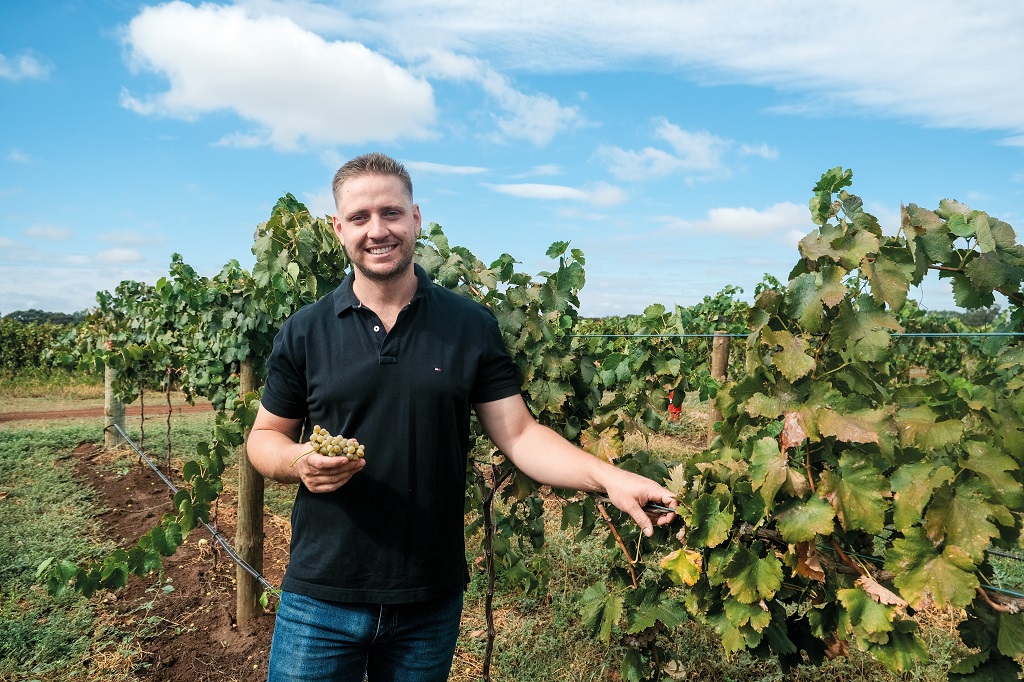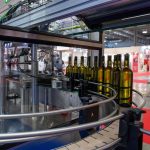By Meg Riley
For Peter Valeri, grapegrowing is as intrinsic to his family history as it is to the region he grew up in. Based in Griffith in NSW, Peter’s drive to pursue winemaking has taken him across the nation, but it’s always brought him back to the Riverina.
Peter Valeri’s grandfather was a grapegrower, and his father is still, with the family traditionally managing commercial-scale vineyards. With the commercial wine market currently presenting some challenges, Peter is finding ways to innovate and pivot, adapting to the environment and keeping the family passion thriving.
Backed by a degree in wine science and viticulture, Peter spent the early years of his career as a winemaker, but now, like his father and grandfather before him, he is becoming more and more involved in the growing side of the equation.
“I suppose I always had that influence, being involved in the industry in some way or another,” said Peter.
The difficult circumstances of the commercial wine climate have led Peter to explore ways to differentiate the family business and draw on the strengths of both his family and his region’s heritage.
“It’s been a challenging climate over the last few years, which is not isolated [to us] here in the Riverina – it’s something which obviously is felt Australia-wide and even across the world – but the price of bulk grapes here in the Riverina is probably at its lowest I’ve ever seen it, and it’s at the point where it’s no longer financially sustainable,” said Peter.
“For us, we wanted to remain in the industry. We’re passionate about wine and growing grapes, and we thought, what is the way that we can differentiate ourselves to add more value to the product, but also produce a product that we’re proud of that can showcase the Riverina and can showcase our passion?”
With Peter’s winemaking background and his father’s lifelong experience in viticulture, Peter said they were fortunate to be able to combine their skills, drawing on their Italian heritage to produce quality wines.
“My grandparents migrated to Griffith from Italy,” explained Peter.
“We’ve just started a project which we’re all pretty excited about, where we’ve planted a small block to Italian varieties. We’re pivoting away from what we’ve traditionally done and trying to build a brand where we can focus on quality and small-scale production and try and carve out a niche to differentiate ourselves in the challenging market at the moment.”
The family is still growing grapes for local commercial winemakers, with around 80 percent of the vineyard currently dedicated to traditional French varieties. The remaining 20% is a 20ha block, planted with alternative varieties, and the focus here is on quality, not scale.
“Outside of the Riverina some people consider that quite big,” said Peter. “But we’ve put as many different varieties on there as we can, and we’re focusing on just keeping it small and not biting off more than we can chew.”
“It’s about doing what’s best in the vineyard and then hoping that converts to good wine.”
Challenge breeds innovation
For many growers in the area, the toughest battle currently is trying to stay financially viable.
“The inputs are increasing and the price of grapes are decreasing, and we’re at a point where profit margins are squeezed to the breaking point, so it’s quite a challenging environment for many of the growers here in the Riverina,” said Peter.
The issue of oversupply in the Riverina is something which Peter believes is sadly unlikely to change dramatically in the near future. He said that in addressing the problem it was inevitable that vines would be pulled out – “something that none of us want to see”.
“We’ve decided to try and focus on a different area, to remain in the industry and to keep on moving forward in something we enjoy doing,” he explained.
Although challenging, this strain has not tainted Peter’s love for Griffith.
“I’ve been fortunate enough to have travelled to different areas and make wine in different regions, but there’s something about being here at home that drew me back and has brought me back here.
We’re pivoting away from what we’ve traditionally done and trying to build a brand where we can focus on quality and small-scale production and try and carve out a niche to differentiate ourselves in the challenging market at the moment.
“It’s quite a multicultural community,” said Peter. “We’ve got a great Italian heritage, and a lot of other people from all different nations have migrated here. So it’s quite a unique country town given [that] geographically, we’re quite isolated from major cities, yet we’ve still got so much culture and great food; great wine.”
“I’m really proud of the town and I’m proud of the community. For me, it’s that unique culture and heritage and connection to the place that makes Griffith and the Riverina quite a unique area.
“On top of that, I really do believe that there’s the potential here to make great wines. There are some great wines already being made in the Riverina, but I think we can build on that even further and hopefully showcase all the different aspects of the quality that we have to offer.”
Homeland and heartland
For growers like Peter who are not ready to give up on the industry, the question becomes not how many vines are in the ground, but what kind.
When diversifying his varieties, Peter is considering the climates of both Griffith and the vine’s origin, the ways in which winemaking style can further enhance the variety and how the end result would fit into the market.
Ideally, he is looking to create a wine that can be enjoyed across multiple markets and moments; something that pairs well with foods – a lighter, medium-style wine, and suits a social, easy-drinking consumption occasion with family and friends.
“It’s part of that Italian heritage that I’ve grown up with, that I’m still influenced by today,” said Peter.
This Italian origin is not only influential to Peter’s winemaking style, it is also central to the process of selecting new varieties, and the climates of the Valeri homeland and heartland mirror each other in their environments.

“We’re quite a warm climate,” explained Peter. “We want something that can handle the heat, that ripens well and holds its natural acidity, [and] is resilient to pests and disease.”
“A lot of the southern Italian varieties which we’ve selected are perfect for this climate, and we think we can produce some styles of wine that are competitive across the market.”
So far, Peter has planted Fiano, Nero D’Avola and Pecorino, with the potential to add even more varieties in the future.
He is particularly excited to grow Pecorino, which is a white variety that comes from Abruzzo in Italy, the same region where his grandmother and grandfather were born.
“My grandfather, when he was born and raised in Italy, they were playing around with those varieties. And now, over time, they’ve been imported to Australia, and I get to do the same thing. That’s something that always sparked my interest early on in my career: whenever I had exposure to any of those varieties I really wanted to get my hands on them and learn as much as I could about them.
“That’s not to say that there aren’t really exciting things about a lot of other varieties. It’s just that we’re in a unique position here where we can highlight ourselves – it’s something different and the climate works for those varieties.
“We’re not the first people to have planted these varieties in the region, there’s already some here, so we’ve seen success from other vineyards in the region and we think we can build upon that and take it to another level by focusing a little bit more on the vineyard and how we can optimise the quality.”
Room to grow
Although he began his career with a focus on winemaking, now with 14 vintages under his belt, Peter has chosen to turn his attention to growing. More specifically, to the small plot of Italian varieties he is nurturing at his family vineyard. Over the last two years, Peter’s time has been dedicated to viticulture, but once the vines are fully established, he anticipates that his role will be split between winemaking and growing.
Peter’s enthusiasm has been bolstered by the Next Crop Program, a Wine Australia-led initiative which encourages young people in regional areas to take on leadership roles and expand their industry confidence. The Next Crop Program is held annually, and in 2023 it visited the Riverina, taking in 14 young wine industry professionals.
“There was a really fantastic cohort of participants last year, who came from all different areas of the industry – it wasn’t just viticulturists and the winemakers,” explained Peter.
“Throughout the entire program there was a really positive vibe that as a group of young leaders, there’s huge potential for our region, and we’re all really motivated and excited about the challenges that we face and how we can overcome them.”
By design, the program aimed to shape the cohort into strong young leaders. Brought together not only by the program but by their shared challenges in the industry, Peter said the relationships formed within the diverse cohort were a source of inspiration and positivity.
“There was an underlying theme of ‘how can we really better the region?’” he said. “How can we work together to collaborate and face the challenges, and continue to build and grow the work that’s been done by so many great people before us?”
One of the toughest realities facing young viticulturists like Peter, especially in regional areas, is maintaining the incentive to stay in the industry, or, as Peter points out, having the incentive to enter the industry in the first place.
“It is going to be a challenge for us to continue to encourage skilled people and young people to enter the industry,” he acknowledged. “But I’m confident that we will do whatever we can to keep that interest there and to keep skilled and talented people involved in the industry.”
From a winemaking standpoint, Peter says there is plenty to look forward to: as the new varieties emerge so too will new winemaking styles and interest in the market. Based on his interactions with other young professionals in the region, Peter has faith that his passion for the Riverina is shared among the burgeoning generation of wine industry leaders.
“Particularly from my exposure to the Next Crop [cohort], everyone was really energetic and everyone came from a range of different backgrounds, and we all felt like we wanted to carry the work that’s been done from all the fantastic people who have built up the Riverina region in the past.”
“That’s a huge weight to carry, because there’s been so many significant people throughout the years who’ve influenced the region. And for us it’s a real custodianship, and an opportunity which we don’t want to let anyone down on.
“It’s quite a privilege and quite an honour to be a part of the industry and to be considered a Next Crop participant and a young leader, and someone who can contribute to the industry in the future.”
“We’ve got a lot of work to do, and we’ll do it, and we’ll continue producing great wines.”
“The ultimate goal for me is focusing on this small block of Italian varieties and creating that into a brand, and hopefully growing it to a point where it’s a successful business and people can enjoy the wines and can see some of the quality that comes out of the region.”
“There’s obviously got to be some sort of market correction to address the oversupply in the industry, and I definitely don’t have all the answers for that. But I think that there’s the right people in the industry to make it happen,” said Peter.
“For me, I can focus on the things that I’m in control of and see how it evolves from there.”
Despite the work ahead of him, Peter has every intention of remaining in the industry and in the region and said he would advise other young people entering the industry to “go for it”.
“You might start off in one area and find that your interest takes you somewhere else, and that’s the excitement of it – there’s always room to grow. There’s always room to continue learning and continue evolving.”
This article was originally published in the April issue of the Australian & New Zealand Grapegrower & Winemaker. To find out more about our monthly magazine, or to subscribe, click here!
Are you a Daily Wine News subscriber? If not, click here to join our mailing list. It’s free!





















